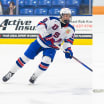Kyle Turris won 15 of 25 faceoffs, including seven of 10 in the defensive zone. Derick Brassard won eight of his 15 faceoffs, including five of six in the neutral zone.
"Pittsburgh managed to get a number of faceoffs in the offensive zone [29], but you watch Ottawa's 'D' zone faceoffs, and Turris' in particular," Corsi said. "What happened was Pittsburgh was sending two guys in off of lost draws, and Ottawa's weakside winger would drop off toward the wall and they'd go 'D' to 'D', two guys chasing, the guy would pass it to the weakside winger and out they go."
The Penguins dominated faceoffs in the third period, winning 17 of 23, including seven of eight in the offensive zone, but they generated seven shots on goal, including one shorthanded. Ottawa lost all those faceoffs and had 14 shots on goal.
Corsi said the Senators were good at tying up and defending after a lost faceoff in the defensive zone.
"There was only one dangerous play," Corsi said. "Generally they'll bring three guys up and they'll make some kind of play, and the way you respond to that is you release your centerman and he goes to the weakside and picks up that weakside guy. The one time it didn't work, the guy stayed with his player and [Phil] Kessel had a walk in. Kessel had a bomb shot and [Cody] Ceci made the block with a crowd in front of the net [at 6:56 of the third period].
"That right now is the theme, the Penguins trying to generate offense on the faceoffs, but Ottawa works the faceoff dot well. That's one of the hallmark parts of the Penguins offense and they couldn't do much with it."


















